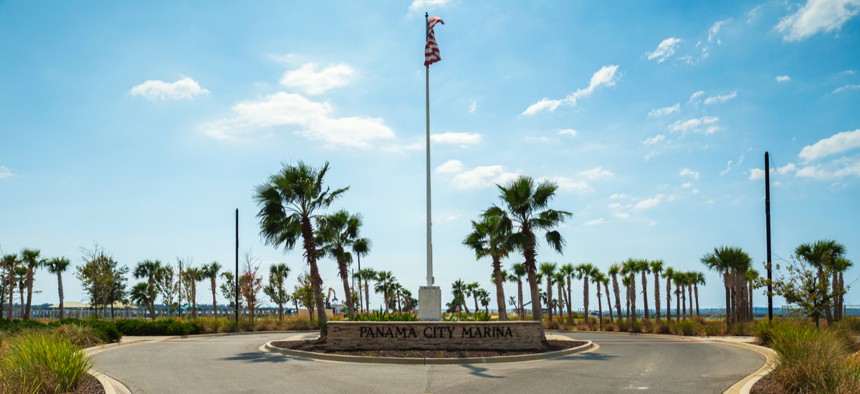From Hurricanes to Pandemics: Benefiting from Crisis Lessons Learned

The marina in Panama City, FL in the wake of Hurricane Michael. SHUTTERSTOCK
COMMENTARY | Elected and appointed officials must anticipate a broad range of possible catastrophes and put effective plans in place now to meet challenges like Covid-19 and future disasters.
From hurricanes to pandemics, all disasters share a common set of characteristics. They are sudden, unexpected, carry severe life-threatening consequences and won’t abate until there is a satisfactory resolution of the underlying situation.
The key to successfully navigating crisis is recognizing the six distinct phases of emotional reaction that come before, during and after a disaster. They start with the pre-disaster phase, when people are gripped with fear about what is to come; next is impact, as everybody juggles different emotions and begins to comprehend the damage toll; and then heroic, when people can act to address the immediate challenges they face. Subsequently, there is the honeymoon phase, when people feel optimistic about how things will work out, which is then followed by disillusionment as individuals confront the totality of the tasks ahead of them. Finally, there is reconstruction, where people come to grips with what they lost and accept the need and timetable for rebuilding.
Viewed through this prism, the re-emergence of Covid-19 and the resulting seesaw between openings and closings is understandable as optimism morphs into disillusionment. For government, that means calibrating its ongoing engagement accordingly.
As the City Manager of Panama City, Florida, where Hurricane Michael made landfall in October 2018 as the first Category 5 storm to strike the U.S. since 1992 and the strongest storm to ever hit the Florida Panhandle—our community knows the evolution of people’s reactions well. To that end, the successful four-part template that guided our recovery can, with some necessary customization, can help communities across the country manage the impact of, and recovery from, the Covid-19 pandemic. The key elements of that template are:
Outline Specific Lines of Effort: There is no question that disasters are complex operating environments. Therefore, the first step is to develop a strategy aligned to each specific function of the recovery effort that is overseen and staffed by the professionals best suited to those tasks and articulate defined goals and success metrics. In response to Hurricane Michael, we identified safety and security, economy, key and vital infrastructure and quality of life as the key lines of effort. This format could serve as an effective coronavirus response framework. For example, communities could focus their coronavirus strategy around health and medical care/personnel, economic continuity, equipment supply chain, community changes, and education. Without this division of responsibilities, the enormity of the crisis leads to confusion of roles and an inability to achieve sustainable progress.
Communicate: There is no such thing as overcommunicating in a disaster. Officials should communicate as often as possible to the widest possible breadth to both internal and external stakeholders through the crisis and its aftermath. Within government that means setting expectations for city employees, like first responders, involved in the response so that they can rise to the occasion. Externally, regular communication to the affected community will foster trust and help reduce anxiety and displace rumor and speculation. Harnessing every communications tool available and driving a reliable cadence of information will earn the trust of citizens that their leaders are acting decisively on their behalf.
Document Work and Accomplishments: The need to prove that work was accomplished through a workflow is crucial. Given the sums of direct and reimbursed federal assistance at stake, and the urgency of the situation, audit trails and transparency play a key role in demonstrating that the assistance was used properly. Moreover, this careful tracking makes it possible for communities to tangibly demonstrate the value the assistance provided.
Prepare Proactively: Simply put, the time to prepare is before the crisis arrives. Start with conducting a candid a vulnerability assessment and then map each major threat to a specific plan of action. Once those are in place, holding tabletop drills that further identify areas of improvement will make the difference between a successful response and one that falls flat. Working through these exercises will help teams make necessary changes that will preserve life and infrastructure. This process also presents opportunities for government leaders to recognize the specific types of relief it can provide like waiving taxes and fees before the crisis occurs.
In Panama City, we are working to become the premier city in the Florida Panhandle. We are doing that by developing a strong bond with our resilient and resolute community and marshaling all of our available government resources to set overall objectives. Never is this more important than in crisis recovery. No challenge is too large or complex, to keep us from fulfilling our duties, not even one as omnipresent as the Covid-19 pandemic.
Mark McQueen is the City Manager of Panama City, FL., and a Major General (Retired), United States Army.
NEXT STORY: Can Civilian Oversight Change Police Behavior?





